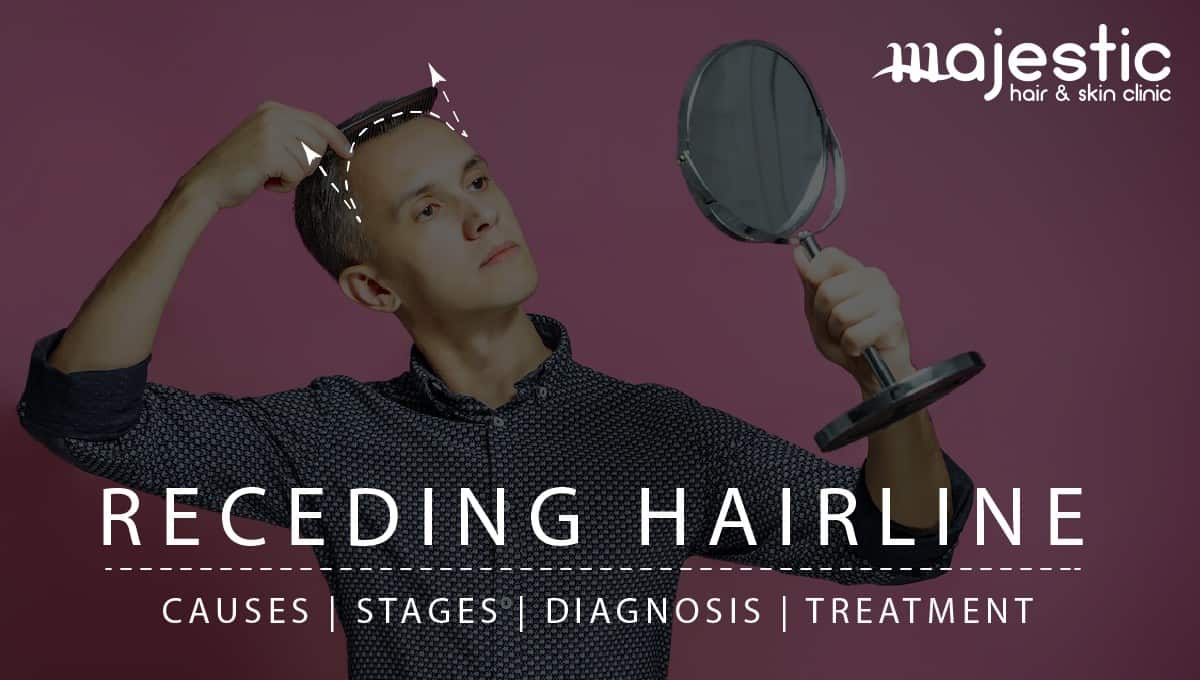A receding hairline is a type of baldness also referred to as a widow’s peak. Genetic factors, along with aging, become the cause of receding hairline. Frontal hair loss generally occurs in males in their early 20s.
It is essential to understand that a certain level of shedding is quite average; most people lose between 50 and 100 hairs daily. Nevertheless, always there are ways you can stop a receding hairline.
What Causes A Man’s Hairline To Recede?
A receding hairline commonly occurs in men due to specific hormones called “Androgen” and “Testosterone.” Androgen and Testosterone also play a vital role in receding hairline.
Male pattern baldness, also known by medical term, Androgenic Alopecia, is mainly due to shrinking hair follicles, and thus making the hair strand thinner, eventually leading to hair loss and worse, baldness.
Men are more prone to oily skin, that causes dandruff, and which may ultimately lead to hair thinning or a receding hairline. The follicles may be clogged if you have oily skin.
Oily skin attracts more dirt, and so these can clog the hair follicles. Once the hair follicles are clogged, it may inhibit the natural growth of the hair, and this leads to baldness.
WHAT CAUSES A WOMAN HAIRLINE TO RECEDE?
Receding hairlines also cause a loss of confidence in some women. A receding hairline can be the result of different causes. These include infectious diseases, excessive hair processing, hair pulling, alopecia areata, autoimmune disorders, thyroid diseases, ovarian tumors, adrenal gland tumors, and burns.
Genetics also play an essential role in female hair loss. Women 30 to 60 years of age may also experience heavy hair loss or hair thinning.
STAGES OF RECEDING HAIRLINE
Stage I:
This pattern of baldness shows minimal hair loss. Hair still appears full, and also hair loss generally goes unnoticed. This type can be considered “normal” for a man in his teens and 20s. If you happen to be stage I in your 30s, you may find yourself lucky.
Stage II:
This stage indicates that hair loss has begun around the temples, but it may be too insignificant to be visible. More often than not, this occurs rather suddenly. Especially when a man is in his early 20s and the last surge of puberty hits. It can also be the cause for alarm for a young man, but it should not mean you are destined to be bald.
Stage III
This is the stage at which hair loss becomes visible as the deeper temporal recessions can be seen. When a man is in his 40s, this could be “normal.” The majority of men undergo some degree of hair loss as they age. It is also the very first stage at which treatment becomes viable.
Stage IV
It shows continuing hair loss around the hairline with more visible thinning at the vertex. When you are trying to slow down the progression, you will want to initiate treatment here, and transplant may be an option.
Stage V
It depicts larger areas of hair loss at front and top of the head. However, at this stage, there is still hair left in mid-scalp.
Stage VI
This stage sees significant hair loss. Most hairs on the top of the head are lost at this point. There may also be some thin hair between the receding hairline and vertex. However, in general, it is one continuous area of hair loss.
Some people refer to this pattern as “horseshoe,” because the hair that remains has a shape of a “U” around sides and back of the scalp. It would take multiple sittings of transplant to restore such a pattern. Moreover, that is also dependent on donor availability, which at this point, is usually not abundant.
Stage VII
This most extreme stage means there is literally no hair at the front and top of the head. The remaining hair sits low above the ears and also at the back of the head.
SYMPTOMS OF RECEDING HAIRLINE:
HOW CAN YOU TELL IF YOU HAVE A RECEDING HAIRLINE?
There is no single pattern which a receding hairline would follow. However, there are also some significant symptoms to keep an eye out for. For example, losing much hair is one such prominent symptom. It’s common for people to lose dozens of strands every day.
1. Your Hairline is quite Uneven:
A growing and a receding one are easily distinguished based on how the hairline gradually recedes.If your front line of hair has receded uniformly, it’s more likely that the hair has matured to match with your even mature facial shape and cutting.
However, if your hairline is not uniform – that is, you’ve less hair at temples than on forehead – this is earliest signs of baldness.
2. Your Temple Hair Is also Thinning:
At this juncture, you can experience more hair loss. In the beginning stages, it can be tough to tell whether your hairline is receding, or if it is false. This is when it’s time to focus in on your temples.
3. You’re experiencing even More Fallout:
It’s entirely reasonable for people – both male and female– to lose anywhere from 50 – 100 strands of hair each day. This is due to continuous cycling that the hair follicles undergo, and it’s nothing which should cause tension.
However, you may also notice that more hair is falling out with increasing time. This is commonly seen on your pillow when you wake, or even in the shower while taking a bath. You can also check your comb each day, cleaning it out and taking a close examination of the fallout which has occurred.
HOW A RECEDING HAIRLINE IS DIAGNOSED?
- Blood Test:
This may help to discover medical conditions related to hair loss.
- Pull Test:
Your doctor here gently pulls several dozen hairs to see how many do come out. This helps determine the stage and intensity of the shedding process.
- Scalp Biopsy:
Your doctor here scrapes samples from the skin, or a few hairs plucked from the scalp to examine the nature of hair roots. This can help determine whether an infection is causing hair loss.
- Light Microscopy:
Your doctor here uses a special instrument to examine hairs trimmed right at their bases. Microscopy also helps discover possible disorders of the hair shaft.
DOES A RECEDING HAIRLINE ALWAYS MEAN BALDNESS?
There are numerous ways for frontal hairline regrowth. In most cases, receding hairline at 18 is a common phenomenon. The receding female hairline at 20 is a cause for mental distress and agony.
Female receding hairline temples becomes very difficult to treat. However, if you successfully follow some essential steps and lead a routine life, you are sure to reap the benefits. So take proper care of your hair and prevent regretting later.
TYPES OF RECEDING HAIRLINES:
1. Widow’s Peak:
Men who have a “widow’s peak” often tend losing hair along sides but not on widow’s peak (at least first) causing the widow’s height to be accentuated. In some cases, the widow’s height will also form an “island” of hair.
2. No Widow’s Peak:
For those who do not have a widow’s peak, the receding hairlines present itself as an ever-growing forehead which at first is slightly less noticeable. These people suddenly notice one day that their hairline is receding.
CAN RECEDING HAIRLINE REVERSE/GROW BACK?
It depends. When a follicle has closed, disappeared, scarred, or even not generated new hair in years, then it will make it difficult for new hair to be able to grow. However, if the follicle is still intact, then it is possible to regrow the hair—or to improve the health of the existing thinner hair strands.
HOW DO YOU STOP A RECEDING HAIRLINE?
1. NATURAL WAYS:
- A Healthy Diet:
Encourage nutritious and balanced diet to combat a receding hairline. Be sure to consume foods that are high in substances such as protein, minerals, carbohydrates, and “good” fats.
- Too Much Hairstyling:
Excessive hairstyling can expedite a receding hairline. Hairstyles such as ponytails and cornrows can also damage the hair shaft and hair follicles. Receding hairline treatment requires avoiding any harsh treatment on hair.
- Receding Hairline Shampoo:
you can also use an organic shampoo which has biotin and caffeine. Best shampoo for receding hairline includes Nizoral, Alpecin caffeine shampoo, and Biotique products.
2. MEDICATIONS
PLEASE NOTE: These medications are given here for information purpose only. We strongly suggest you to consult a doctor for diagnosis of the cause of your hair problem and prescribe a suitable medicine for you. It is not advisable to take any medicines without the suggestion of your dermatologist.
- Finasteride or Dutasteride:
In men, testosterone can also be converted into DHT, which can cause tremendous hair loss from the head. The prescription drug finasteride (Propecia) is also produced specially for male hair loss. Its primary purpose is slowing down the rate that testosterone turns to DHT, thus reducing DHT in the body.
This may even make it easier for some men to grow hair or minimize hair loss. The drug Dutasteride (Avodart) is a special medication explicitly designed to treat an enlarged prostate, though it is also often prescribed to help encourage hair growth and restoration.
These effects will typically wear off immediately as the person stops taking the drugs.
- Minoxidil:
Minoxidil (Rogaine) is a very effective scalp treatment that has generally been approved by the United States Food and Drug Administration (FDA) to prevent hair loss. The effects mainly last as long as a person uses the treatment, but baldness will return once a person stops using it.
Does minoxidil work on hairline?
Minoxidil was initially deemed ineffective for proper cure of a receding hairline. That belief was later found to be inaccurate.
After 48 weeks of using minoxidil, the majority of men report noticeable and positive improvements to receding hairlines. Apply minoxidil twice daily and also use the product continually. When you stop using minoxidil, any gains will also disappear.
- Anthralin:
A prescription for anthralin (Dritho-Scalp) may also help in new hair growth in quite a few people. It is a topical psoriasis medication, though it is often used to help spark new better hair growth.
- Corticosteroids:
Some corticosteroid treatments may also help to treat hair loss. This medication would work by effectively reducing the inflammation around the hair follicles, allowing them to open back up and grow new hairs.
Corticosteroids may also produce adverse side effects, so anybody considering using these medications should discuss their use with a doctor.
3. Hair Transplants and Laser Therapy
Hair transplant is the most cost-effective and attractive way of receding hairline treatment and combat frontal hair loss.
A hair transplant involves taking hairs and parts of scalp from thicker spots on the head and also moving them to front filling in receding hairline. The process may be cost-effective, but many people feel it is a more long-term and permanent solution when compared to a receding hairline.
Laser therapy using red light or laser at a wavelength of 660 nanometers may also increase hair growth in some people and consequently reduce male pattern baldness.
4. Essential oils
Some essential oils may also be promising suitable hair-growth agents. In a study, the mice that had peppermint essential oil rubbed for four weeks also showed the most noticeable signs of hair growth when compared to any other group. These help in frontal hairline regrowth.
HOW TO STOP RECEDING HAIRLINE AND REGROW HAIR?
1. Go easy on your scalp
Are you a regular head rubber? Too much pressure like brushing your hair and scratching your scalp can damage your hair follicles, which can lead to a receding hairline.
If an itchy scalp leaves you constantly scratching your head, you might want to use different shampoo options – wanting something to prevent dandruff. Try looking for a receding hairline shampoo which has pyrithione zinc as the active ingredient.
2. Spend some time doing something you enjoy
Do you find yourself stressed and worried every day? It could be an essential factor for your receding hairline. Since stress is linked to hair loss, experiencing many anxious days may be causing your hairline to recede faster than it should.
If you feel stressed and anxious, spend a little time every day doing something that keeps you involved. It could be going for a walk, exercising, or even reading a good book – whatever it takes to help you stay active.
3. Eat healthier meals
If your diet is not providing you the right vitamins and minerals you need, your hair is one of the first things affected. As soon as you start noticing that you’re losing more hair than usual, take a look at your current diet. Having fast food, frozen dinners, and processed foods may be one of the crucial factors behind your receding hairline.
The good news is that fixing your diet is also very quick and easy. All you need to do is add some more fruits and vegetables to each meal, or don’t skip on daily multivitamin dose; if you do both, then you’ll be having healthy.
WHAT TO DO IF A HAIRLINE IS RECEDING?
- Hairstyles
Changing the way a person with receding hairline styles, their hair may also help draw attention away from it. A stylish example is the slicked back undercut, where a person keeps the hair on top and also cuts sides shorter.
Once long enough, the person slicks back the hair on top of the head, with a comb or gel. This style can make the hair look thicker and luscious and also cover up any area of baldness.
Other classic examples that make men with receding hairlines look handsome include a close buzz cut, medium crew cut, or even a clean shave in some cases.
- Lifestyle Choices
As stress and anxiety may play a significant role in hair loss. Finding ways to reduce stress also help to manage a receding hairline. Regular exercise, eating a healthy diet, and even taking time to reduce stress and anxiety factors may help people manage their symptoms of hair loss.
- Haircare – COSMETICS
Taking care of beautiful hair can be an essential step towards keeping it on the head of all. Using natural hair products or at least avoiding harsh chemicals regularly can be a step towards rejuvenating the hair.
It may also help to prevent vigorous brushing or to pull the hair too much frequently. Use organic shampoo and castor oil to minimize hair loss.
TAKEAWAYS – SOME POINTS TO NOTE:
A recession in hairline can be seen in men and women both. It is more common in men. It is one of the very first signs of baldness and can be caused by various factors. A receding hairline shows different symptoms. Symptoms may also develop just after the end of puberty or anytime throughout adulthood.
Most people can manage to hide their receding hairline, and there are some treatments also available with a minimized cost that can help the hair look fuller or help it to regrow.
Anybody considering to try these treatments should discuss them thoroughly with a healthcare provider to find the most suitable option available for him.
CONTACT US:
Please feel free to contact us and share your thoughts on this article. Also, if you are facing problems related to receding hairlines, you may contact our hair experts. Majestic Hair and Skin Clinic is a place where we take care of every individual customer and help him/her find out the reason behind their recession in hairlines and also provide adequate treatment.
So, do not waste any more time and contact us as soon as possible to treat your hair in a better way BECAUSE- “Your hair is your best accessory!” and you need to take care of it.



